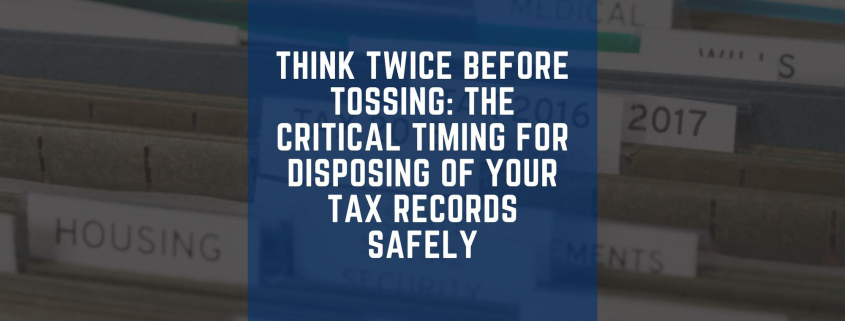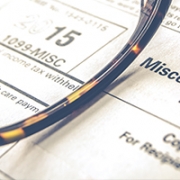Think Twice Before Tossing: The Critical Timing for Disposing of Your Tax Records Safely
- Learn the correct duration for keeping tax records.
- Examine Federal Statute of Limitations for tax refunds.
- Define problems and possible solutions involving keeping tax records.

Now that your taxes are complete and filed for last year, you are probably wondering what old tax records can be discarded. If you are like most taxpayers, you have records from years ago that you are afraid to throw away. To determine how to proceed, it is helpful to understand why the records needed to be kept in the first place. Generally, we keep “tax” records for several reasons:
Audit Defense:
In the event of an IRS audit, taxpayers are required to present documentation supporting the claims made on their tax returns. Without proper records, defending against audit adjustments becomes significantly challenging.
Amending Returns:
If taxpayers need to amend a return due to discovered errors or overlooked deductions, having detailed records makes the process smoother and ensures that all adjustments are accurate.
Claiming Refunds:
For claiming refunds, especially those related to overpaid taxes, detailed records are necessary to substantiate the claim.
Tax Basis:
When capital assets, such as stock, business assets, rentals, and other investments are disposed of it is necessary to determine for tax purposes if there was a gain or loss from the transaction. The tax basis is what the asset cost plus or minus adjustments such as the cost of improvements which increase the tax basis, depreciation (reduces basis), casualty losses, or tax credits which decrease the tax basis.
Duration for Keeping Tax Records
The general rule of thumb is to keep tax records until the statute of limitations for the tax return in question expires. The statute of limitations is the period during which the taxpayer can amend their tax return to claim a credit or refund, or the IRS can assess additional tax.
Federal Statute of Limitations on Tax Refunds:
The statute of limitations on tax refunds is a set of rules defined by the Internal Revenue Code that determines the time frame within which a taxpayer can claim a credit or refund for overpaid taxes. This statute serves two main purposes:
- It specifies how long an individual has to file a claim for a refund or an amended return after the original return was filed or the tax was paid.
- It sets limits on the amount of refund or credit that can be claimed, based on certain conditions. Some states have longer statutes, typically 4 years, so they have more time to piggyback on any federal audits and adjustments. Example: Sue filed her 2023 tax return before the due date of April 15, 2024. She will be able to safely dispose of most of her records after April 15, 2027. On the other hand, Don files his 2023 return on June 2, 2024. He needs to keep his records at least until June 2, 2027. In both cases, the taxpayers should keep their records a year or two longer if their states have a statute of limitations longer than three years. Note: If a due date falls on a Saturday, Sunday, or holiday, the due date becomes the next business day.
Tax Return Omissions:
In certain situations, such as when a taxpayer does not report income that they should report, and it is more than 25% of the gross income shown on the return, the IRS suggests keeping records for six years.
Of course, the statute doesn’t begin running until a return has been filed. There is no limit on the assessment period where a taxpayer files a false or fraudulent return to evade tax.
Indefinite Retention:
For records related to property, the IRS recommends keeping them for as long as the property is owned and for at least three years after filing the return reporting the sale or other disposition of the property. This is crucial for calculating depreciation, amortization, or gains or losses on the property.
Financially Disabled:
Additionally, taxpayers who are 'financially disabled' experience a suspension in their periods for claiming a refund. A taxpayer becomes financially disabled when a medically determinable physical or mental impairment prevents them from managing their financial affairs and is expected to result in death or last continuously for at least 12 months. For a joint income tax return, only one spouse needs to be financially disabled to suspend the time. However, if the spouse or another person is authorized to act on the taxpayer's behalf in financial matters, the taxpayer is not considered financially disabled during that period.

The Big Problem
The problem with discarding records indiscriminately for a particular year after the statute of limitations expires is significant. Many taxpayers combine their normal tax records and the records needed for capital assets like stocks, bonds, and real estate. These documents need to be separated. The basic records should not be discarded before the statute expires for the year the asset is disposed of. It makes more sense to keep those records separated by asset. The following are examples of records that fall into this category:
Stock Acquisition Data
If you own stock in a corporation, keep purchase records for four years after selling the stock. This data is needed to prove the profit or loss from the sale. If losses exceed $3,000 ($1,500 if married filing separately), keep records for four years after using up the loss. This includes records of all capital asset sales.
Stock and Mutual Fund Statements
Many taxpayers reinvest dividends from stocks or mutual funds into more shares. These reinvested amounts add to the property's basis, reducing gains when sold. Keep statements for at least four years after the final sale.
Tangible Property Purchase and Improvement Records
Keep records of home, investment, rental, or business property acquisitions and related improvements for four years after selling the property.
If your business has a net operating loss (NOL) carried forward, keep income and expense records from the loss year. Retain these records for four years after using the NOL deduction.
The 10-Year Statute of Limitations on Collections
"How long does the IRS have to collect unpaid tax?" is a common question. The tax code limits the IRS to 10 years for tax debt collection. This period starts from the tax assessment date, not the tax year.
Understanding this limitation is crucial for taxpayers. The IRS uses collection activities like tax liens, levies, and wage garnishments within the 10-year limit.
Installment Agreements
When unable to pay immediately, taxpayers may enter installment agreements with the IRS. The 10-year period continues during these agreements. The IRS must collect the full amount within the original 10-year period unless extended by specific conditions.
Have questions about whether to retain certain records? It is better to be sure before discarding something that might be needed down the road. If you have questions or need assistance, schedule a consultation with a Fiducial advisor at https://fiducial.com/consultations.
Know someone who might need our services? We love referrals!









